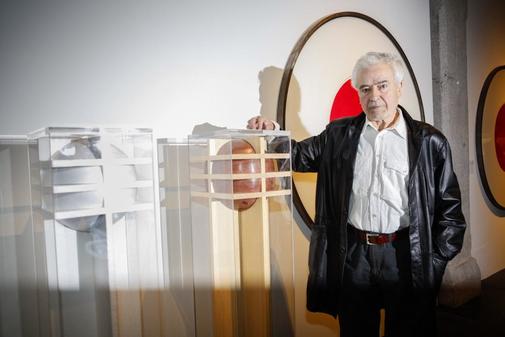- Cruz Novillo.All the fruitful art of the lord of the logos
- Creator of the EL MUNDO logo, José María Cruz Novillo, second designer to enter the Royal Academy of Fine Arts
- Arte.Cruz Novillo, the creator of the endless
The logo of the fist and the rose of the PSOE, the flag of the Community of Madrid, the shield of the National Police or the brand image of Correos, Repsol or Renfe or EL MUNDO. All that and more came out of the imagination of the same man, José María Cruz Novillo, whose career reviews the documentary The Man Who Designed Spain.
Directed by Andrea G. Bermejo and Miguel Larraya, the film has just been presented at the Seminci de Valladolid and in Abycine Indie and has testimonies such as that of the historic leader of the PSOE Alfonso Guerra.
Guerra says, author of the famous phrase "Spain is not going to know her or the mother who gave birth to her," that Cruz Novillo perfectly exemplifies that revolution in the visual and semiotic aspects at a time, the Transition, in which everything was to be done, economically but also aesthetically, and in that the word 'design', in its current professional sense, did not even exist .
Born in Motilla del Palancar, Cuenca, in 1936, Cruz Novillo remembers in a camera interview the luck he had when, as soon as he arrived in Madrid at the beginning of the 60s, he went to work in the Art department of the agency advertising Clarín and they sent it directly to Manhattan.
His first assignment was to devise the image for the Spanish pavilion at the New York World's Fair. He spent five months living in the Plaza Hotel and working in a New York agency in the purest Mad Men style. It was a full-fledged master , remember.
Upon returning, the work began to rain for public institutions that until then had no more logo than the Spanish flag. He drew the first emblems for the Public Treasury, the Foreign Bank of Spain or TVE.
The PSOE also commissioned his logo and asked him to be inspired by the fist and rose that Yan Berriet had designed in the early 1970s for the French Socialist Party. They wanted him more slender and stylized, more strongly, says Guerra.
The series of pesetas tickets with images of Spanish writers, the National Police shield and even the color of their uniforms , which went from brown (hence the popular denomination 'maderos') to dark blue, were also his work.
The documentary, which can be seen on November 19 at the Cineteca de Matadero, in Madrid, narrates in the mouth of the then president of the Community of Madrid, Joaquín Leguina, the suspicion with which the starry red flag of Cruz Novillo was received by his "Marxist" resonances.
The red one was the one of the flag of Castile "of all the life" and the stars, a representation of the constellation of "Osa", explains Leguina who thanks that, once Alberto Ruiz Gallardón happened to him in the presidency, the controversy It was finally settled.
In addition to his work for companies, institutions and media such as the Prisa, El Mundo or La Cope group, Cruz Novillo is the author of numerous movie posters that also marked the era as the National Shotgun of Berlanga, The Spirit of the Hive by Víctor Erice or many by Carlos Saura, from Cría cuervos to La prima Angélica .
A facet of the latter that he developed through a then young José Luis Borau ( Furtivos , 1975) who had come to work as an editor in his same agency and who put him in contact with Elías Querejeta, the great independent producer of the time.
The colorful exterior design of the headquarters of the National Institute of Statistics (INE) in Madrid is also a creation of Cruz Novillo, whose hallmarks, according to his son in the documentary, were the aversion to the routine, prioritize beauty over functionality and not never follow the dictation of fashion.
According to the criteria of The Trust Project
Know more- culture
Sitges Film Festival: 'Paradise hills' stands out between the calculated coldness of 'The Lodge' and the festive chaos of 'Wedding Night'
MúsicaGreen Day will perform at the Plaza de España in Seville on November 2 during the MTV Music Week
Flags An exhibition of 'ninots' exhibits 'stelae' and yellow ties in the Ethnological Museum of Castellón

